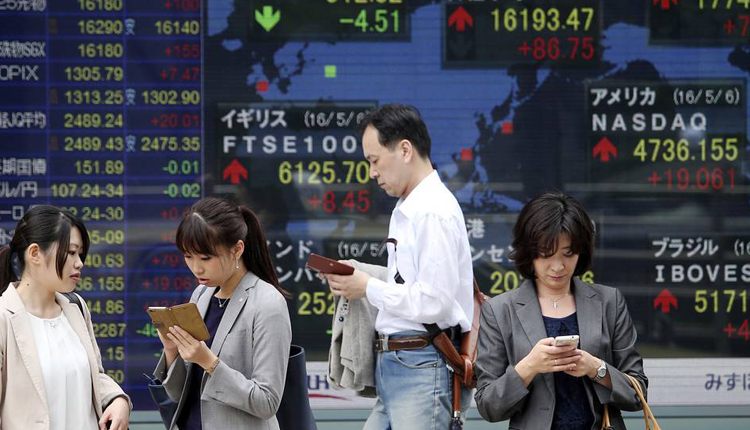Asian stocks slipped in Tuesday afternoon trade, while investors looked toward a meeting between U.S. President Donald Trump and Chinese President Xi Jinping set to happen later in the week.
Mainland Chinese stocks led the declines as they slipped by the morning session’s end: The Shanghai composite shed 1.82% and Shenzhen component fell 2.12%. The Shenzhen composite also dropped 2.04%. In Hong Kong, the Hang Seng index slipped 1.31%.
China-listed bank shares tumbled amid concerns over increased lending to small firms, which could be vulnerable to an economic slowdown. Bank of Communications dropped 3.02% and China Construction Bank fell 2.15%. Their Hong Kong-listed counterparts shed 4.03% and 0.91%, respectively.
The Nikkei 225 in Japan slipped 0.44% in afternoon trade and the Topix shed earlier gains to decline 0.24%.
Over in South Korea, the Kospi was 0.15% lower, while Australia’s S&P/ASX 200 shed 0.12%.
The Japanese yen, widely viewed as a safe-haven currency, traded at 106.90 against the dollar after touching lows around 107.5 yesterday. The Australian dollar changed hands at $0.6960 after rising from levels below $0.695 in the previous session.
Investors await a highly-anticipated meeting between Trump and Xi at the upcoming G-20 summit in Japan. The two leaders are expected to discuss the protracted trade fight between their two countries.
China and the U.S. have already slapped tariffs on billions of dollars worth of each other’s goods over the past year. In May, the two economic powerhouses hiked tariffs targeting some goods. The Trump administration has said previously that Trump is ready to raise tariffs on all Chinese imports into the U.S. if the two countries fail to arrive at a deal.
China’s Ministry of Commerce said in a statement on Tuesday that the country’s Vice Premier Liu He had a phone call with U.S. Treasury Secretary Steven Mnuchin and U.S. Trade Representative Robert Lighthizer on Monday. They discussed trade and agreed to maintain communications, according to the statement.
Overnight on Wall Street, the Dow Jones Industrial Average closed 8.41 points higher at 26,727.54, while the S&P 500 declined 0.2% to finish its trading day stateside at 2,945.35. The Nasdaq Composite closed 0.3% lower at 8,005.70.
There appeared to be a “consensus building” in the U.S. markets that Trump and Xi are set to “agree to not only resume talks but hold off on tariffs for a defined amount of time,” according to Hannah Anderson, global market strategist at J.P. Morgan Asset Management.
She, however, sounded a note of caution to CNBC: “I think that might be getting a little bit ahead of where negotiations are likely to come out.”
The potential U.S.-China developments come as expectations have risen for an interest rate cut from the U.S. Federal Reserve. The central bank opened the door to that possibility last week.
“A July cut is very likely, whether there (is) a truce or not. I think the key difference that a truce means for the Fed is that if there is a truce, it could be one cut. It could be a 25 basis point cut. If there is actually no truce, it could be a 50 basis point cut,” Tan Teck Leng, Asia Pacific foreign exchange analyst at UBS Global Wealth Management, told CNBC on Tuesday.
The U.S. dollar index, which tracks the greenback against a basket of its peers, last traded at 95.901 as it continued to slide from levels above 97.2 seen last week.
Tan, for his part, said the dollar is “already in a structural drift lower” for the next six to 12 months.
“Even if the Fed doesn’t cut as much as market expectations in July, the fact is that the economy is slowing very sharply,” he said. “This year, U.S. GDP is growing at about 2.8 to 3%, next year we are looking at 2% of GDP growth. So, it is a tremendous slowdown.”
“Even if the Fed might be cutting once or twice, we can’t rule out that, going into next year, they might actually need to ease more than that. So, that is the context where the dollar index could easily go below 95,” the analyst said.
Markets are also keeping an eye on the latest developments after the U.S. on Monday imposed sanctions on Iran over last week’s shooting down of an unmanned American drone. Tensions between the two countries have remained high since a recent attack on oil tankers near the Strait of Hormuz, sending crude prices higher.
The latest sanctions by Washington on Tehran “appear to be more gloss than substance” given that the current restrictions are “already very harsh,” Tapas Strickland, markets strategist at National Australia Bank, wrote in a note.
Oil prices were lower in the afternoon of Asian trading hours, with the international benchmark Brent crude futures contract slipping 0.59% to $64.48 per barrel. U.S crude futures were 0.83% lower at $57.42 per barrel.
Source: Reuters
